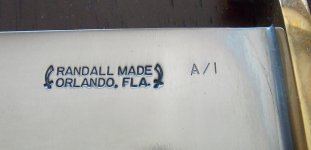jag312
Member
I have been shown a Randall Smithsonian Bowie. There are two things that bother me about the knife. It feels like the blade has never been sharpened. I can run my finger along the blade, and nothing. If I tried that with my other Randalls, there would be blood.
Also, there is a small "A/I or A/1 stamped next to the Randall Made on the left side of the blade. See the pictures. The knife seems to be similar to one I have, but my knife is still packed in a box in storage, and I can't get my hands on it to compare. I don't remember the A/I on any of my other Randalls.
There are people here who know more about Randall knives than I do. What is your opinion?
Also, there is a small "A/I or A/1 stamped next to the Randall Made on the left side of the blade. See the pictures. The knife seems to be similar to one I have, but my knife is still packed in a box in storage, and I can't get my hands on it to compare. I don't remember the A/I on any of my other Randalls.
There are people here who know more about Randall knives than I do. What is your opinion?




